John Gavilanes /Director of Engineering/ Lapp USA
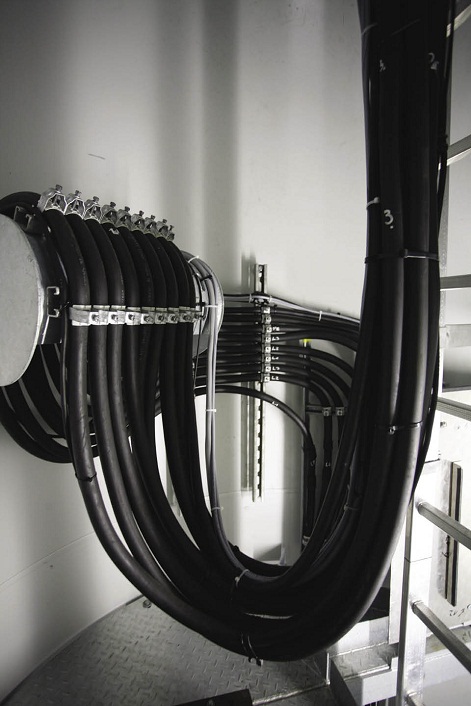
Cables in a drip loop are susceptible to continued strain due to the axial rotation of the nacelle relative to the static tower. Twisting such large cables in temperatures down to -40°C, and making sure their jacket and insulation tolerate common turbine lubricants requires selecting them on more than voltage and current.
Today’s wind turbines are assembled from a vast array of sophisticated components subject to damage from their harsh operating environments. Among the most critical and overlooked components in turbine systems are the cables that handle power and data transmission.
Cables for wind-energy applications must be selected carefully because they can fail when exposed to temperature extremes, chemicals, and electromagnetic interference (EMI) found in wind turbines. Cables must also be rigorously tested to make sure they meet industry standards.
Here’s an update on the current state of standards for wind turbines in North America, as well as a more in-depth look at the factors design engineers and maintenance crews should consider when selecting cabling for wind-turbine applications.
Code changes in North America
As the wind industry expands, the need to ensure the proper installation and safe operation of wind turbines has prompted mandates that provide clearly written safety standards. While utilities are monitored by government agencies, non-utility applications are guided by the National Electrical Code (NEC). In 2011, a new section called Article 694 was added to the NEC to ensure installation safety of small wind electric systems. NEC Article 694 covers small wind power turbines rated for 100 kilowatts (0.1kW).
To establish consistency and prevent confusion, UL has drafted several subjects corresponding to wind-turbine generating systems: UL Subject 6141: Large Wind Turbine Systems (WT) and Electrical Subassemblies, and UL Subject 6142: Small Wind Turbine Systems and Electrical Subassemblies. Wind turbines with entrance access are defined as “large” per UL 6141. They are grid-connected and used for “utility” applications. Wind turbines without entrance access are defined as “small” per UL 6142. They are not connected to the grid and are considered “non-utility.” As the industry grows and the emphasis towards revision of standards continues, UL 6141 and 6142 will be upgraded to include new requirements.
In addition, corresponding UL Standards focus on specific internal components within the wind turbine. For example, Rotating
Electrical Machines must meet UL Standard 1004–1. Electric Generators must meet UL Standard 1004–4. Cables are permitted in UL Standard 1004–1 AWM (appliance wiring materials), but only with exceptions. For instance, Section 20.2 allows use of either standard building wire or AWM. Section 20.4 permits AWM, provided it has an insulation thickness appropriate for the insulation material type and meets stringent cable construction requirements. While UL Standard 1004–1 allows for the AWM option, building wire is a “listed” product, qualifying it as an NEC compliant wiring method. It’s worth noting, however, that AWM is not an NEC acceptable wiring method, so it may be subject to potential acceptance issues during an inspection.
Inside a wind turbine, cable trays or raceways route and support cables to accommodate power for the various operating systems. To address safety concerns regarding the performance of cables under operating conditions inside a turbine, UL released an outline of investigation for “Flexible Motor Supply Cable and Wind Turbine Tray Cable.” This outline,
referred to as UL 2277, permits a 1,000V rating and specifies safety and performance requirements for cables intended for a trays or raceways in the wind turbine. UL 2277 mandates that cables used in a cable tray or raceway in the wind turbine must also meet all performance criteria of UL 1277, known as the “Tray Cable” standard.
Design considerations
In addition to the guidelines set forth by these standards, there are other physical and electrical factors to consider when specifying cables for wind turbines. For instance:
Grease, oil, and hydraulic fluids. Many components within the wind turbine require grease, oil, or hydraulic fluid to function correctly. Oils and grease prevent premature wear on gears and bearings, and hydraulic fluid is necessary for brake systems. However, these lubricants can attack and degrade certain cable jacket compounds. Accidental contact is considered routine in several areas of the wind turbine, so cables can be exposed for long periods of time.
The jacket is the first line of defense for the cable. Oils, grease, and hydraulic fluid can attack a cable jacket through different mechanisms. For example, absorption by the compound results in its swelling to the point where the jacket weakens and falls apart. Another mechanism, extraction of the softening components from the compound, causes the jacket to eventually harden, shrink, and crack. Once compromised, chemicals migrate through and begin to attack the insulation. To avoid these problems, make sure the selected cables are resistant to these types of chemicals and are compliant with UL standards Oil Res I and Oil Res II requirements.
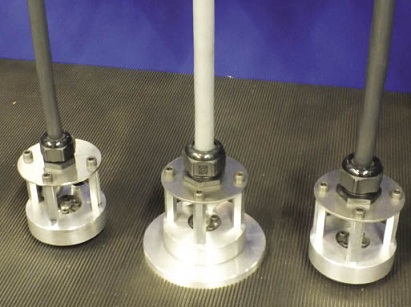
For a torsional twist test, cables are terminated and secured at one end. The other connects to a current source while being tested. A computer keeps the cycle count and monitors the current.
Low temperature exposure. Depending on geographic location, the wind turbine’s operating environment can quickly become cold and remain that way for extended periods. This makes it critical to consider whether the selected cables can withstand cold conditions. Once the jacket has been compromised, the insulated conductors are exposed and subject to the surrounding environment. This can create a potentially hazardous condition. To avoid these issues, look for cables that maintain their handling performance at the lowest temperature extremes. A few cables designed for use in wind turbines can pass the –40°C cold impact test per UL and CSA standards.
Flame resistance. If a fire occurs in the wind turbine, vertically exposed groups of cables can act as flame conduits from section to section, so it is critical to specify cables with high flammability resistance. You can verify a cable’s flammability resistance by making sure it has been tested to the stringent requirements of the CSA FT4 flame test. This test requires loading groups of cables within a vertical tray ladder and then exposing them to an extreme, intense, and 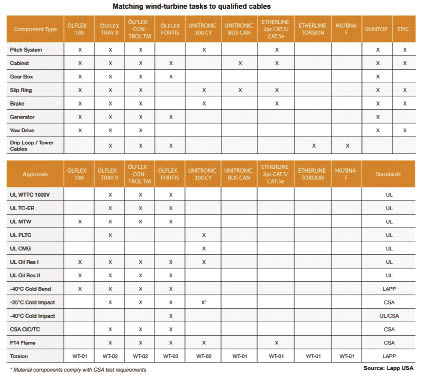 horizontal flame for 20 minutes. Certain criteria must be met regarding flame spread, such as cable charring and damage, and self-extinguishing characteristics. The FT4 flame test provides assurance that flames will only progress vertically to a certain point and then self-extinguish. In Europe, most cables offered for wind turbines only comply with the UL VW–1, CSA FT1, or the IEC 60332–1.
horizontal flame for 20 minutes. Certain criteria must be met regarding flame spread, such as cable charring and damage, and self-extinguishing characteristics. The FT4 flame test provides assurance that flames will only progress vertically to a certain point and then self-extinguish. In Europe, most cables offered for wind turbines only comply with the UL VW–1, CSA FT1, or the IEC 60332–1.
Electromagnetic interference and shielded cables. Because wind turbines are comprised of many electrical systems, electromagnetic interference (EMI) is a common concern. Cables are highly susceptible to it. This is especially true in models with space constraints, where a noise source is often located near sensitive equipment, increasing the likelihood of failure from EMI. Shielded cables help provide protection against sudden high current surges that may occur on a cable connected to sensitive equipment, such as the CPU of the wind turbine. Protection against current surges is a primary reason shielded cables are required in certain areas of the wind turbine. To provide the best protection, look for a product that incorporates the correct shielding design into the cable construction.
Because transfer impedance is a key parameter in determining the shield’s performance of a cable, select a cable with low transfer impedance. It’s also worth noting that the type and quality of the cable shield, and how it is terminated can also improve noise immunity.
Specifying the proper cabling is a simple way to keep wind turbines up and running. By adhering to industry standards and paying attention to the type of physical exposure the cable will see in use, design engineers can pick cables that will provide long uninterrupted service life even in the severe environments common to wind farms. WPE
Electromagnetic interference and shielded cables
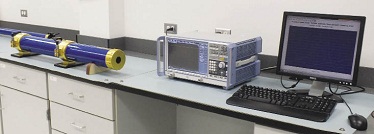
The test equipment used by Lapp USA includes a network analyzer with precision tube to measure the transfer impedance of a shielded cable. The transfer Impedance test is performed per EN 50289–1–6 / IEC 62153–4–3 Ed2 Surface Transfer Impedance – Triaxial Method.
Because wind turbines use many electrical systems, electromagnetic interference is a common concern. Cables are highly susceptible to it. Because transfer impedance is a key parameter in determining the shield’s performance of a cable, select a cable with low transfer impedance. It’s also worth noting that the type and quality of the cable shield and how it is terminated can improve noise immunity.
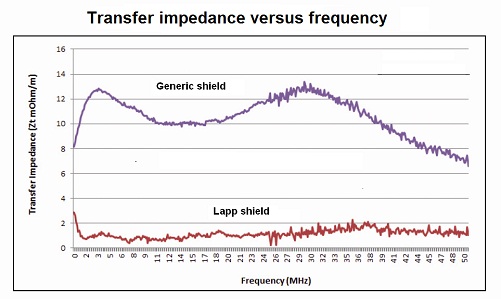
The transfer impedance, measured in milliohms/meter, shows that shielded cable from Lapp USA performs better than generic shielded turbine cable.
A few UL electrical standards for wind turbines
Here are a few UL standards that pertain to wind turbines. Operations and maintenance crews and designers should be familiar with these.
UL Subject 6141 – Large wind turbine systems. These requirements cover large wind turbine systems (WT) and electrical subassemblies. With respect to this standard, large wind turbines are those in which a user or service person may, or is intended to, enter the turbine to operate it or perform maintenance. These WT are for use in utility-interactive, grid-tied applications that operate in parallel with an electric power system (EPS) to supply power to common or stand-alone loads. This standard includes requirements for WT intended for EPS grid connections at transmission, sub-transmission, and distribution levels, depending on the specifications of the specific WT.
UL Subject 6142 – Wind turbine generating systems, small. These requirements cover small wind turbine systems and electrical subassemblies. With respect to this standard, small WT are those in which a user or service person is not intended or required to enter the turbine to operate or to perform maintenance. These units are for use in stand-alone (not grid-connected) or utility-interactive applications. Utility-interactive, grid-tied WT operate in parallel with an electric power system to supply power to common loads.
UL Subject 2277 – Outline of investigation for flexible motor supply cable and wind turbine tray cable. This outline covers requirements for Wind Turbine Tray Cable rated 1,000V, 90 to 200°C dry and optionally rated 90°C wet. It also covers the requirements for Flexible Motor Supply Cable rated from 1,000 or 2,000V and 90°C dry.
UL 1004–1 – Standard for rotating electrical machines – general requirements. This Standard applies to rotating electrical machines and linear motors, ac and dc, rated for 7,200V or less. It is used to evaluate motors intended for field and factory installations. The requirements of this Standard that address the risk of fire do not apply to a motor provided with a metal enclosure where there are no openings in the enclosure through which molten metal, burning insulation, flaming particles, or other ignited material could fall onto flammable material, or through which a flame could be projected.
UL 1004–4 – Standard for electric generators. UL intends that users read this Standard with the general requirements of UL 1004–1. Requirements in this Standard supplement or amend the requirements in UL 1004–1. The requirements of UL 1004–1 apply unless modified by this Standard. This Standard covers electric generators, that when coupled with prime movers, such as engines or electric motors, are used to produce electricity. It covers generators (dc machines) and alternators (ac machines) rated 7,200V or less.
CSA C61400–1–08 – Wind Turbines – Part 1: Design Requirements. This part of IEC 61400 specifies essential design requirements to ensure the engineering integrity of wind turbines. Its purpose is to provide an appropriate level of protection against damage from all hazards during the planned lifetime. This standard is concerned with all subsystems of wind turbines such as control and protection mechanisms, internal electrical systems, mechanical systems, and support structures. This standard applies to wind turbines of all sizes. For small wind turbines, IEC 61400–2 may be applied.
Wind torsion attributes and test standards
The drip loop in wind turbines’ tower cables are subjected to a severe degree of strain, so it is critical to use cables that can withstand it. This strain, in the form of vertical torsion, is created when the turbine nacelle turns. When selecting a cable for this application, look for cables that have been designed specifically to accommodate the torsional stresses caused by repeated turns within the turbine.
Lapp has developed torsion and bending-test equipment to ensure that its cables will continue to perform under extreme conditions. For the test, cables are set up in a vertical formation, connected to a current source, and subjected to the required cycles of torsional twisting at the specified test angle. A computer monitors the number of test cycles 24/7 and records the data. After reaching the required test-cycle interval, testing is complete. The number of completed cycles, however, does not indicate a cable failure has occured. Because of this stringent testing, Lapp has established the industry-standard cable attributes WT-01 and WT-02 to evaluate torsional cable performance. WT-01 passes the minimum UL 1277 Cold Bend Test at –20°C. WT–02 passes the –40°C Cold Bend Test. Some products pass the UL 1277 Cold Impact Test at –40°C.
Filed Under: Cables & connectors, Featured, News, O&M








